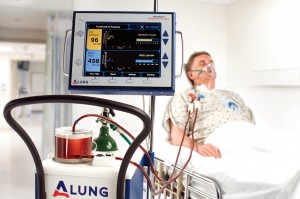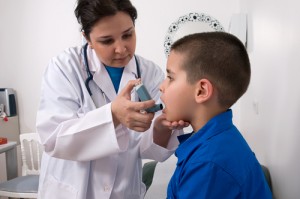Throughout 2014, several new discoveries were made for the treatment of disorders of the lungs, such as chronic obstructive pulmonary disease (COPD), emphysema, cystic fibrosis (CF), lung cancer, and pulmonary fibrosis (PF). Lung Disease News covered all of the major developments in science concerning these diseases throughout the year. The following are the top 14 lung disease-related news stories from this year, based on the total number of views that each article received:
 #14. “Coming Soon: Smartwatch that Monitors SpO2 and Vital Signs in COPD“
#14. “Coming Soon: Smartwatch that Monitors SpO2 and Vital Signs in COPD“
The medical Smartwatch BuddyWOTCH, short from Walking, Oxygenation, Temperature, Chronicle or image capture, and Heartrate, was created and presented by the biomedical company Aseptika Limited. Designed to monitor patients who suffer from COPD, it enables the self-management of blood oxygen saturation and other key vital signs.
#13. “New Stem Cell Research Offers Insights Into Novel Emphysema Therapies“
While COPD and emphysema patients currently lack effective therapeutic options, a group of researchers have been working on better understanding the use of different mesenchymal stem (stromal) cells (MSCs) in treating experimental emphysema. The study, entitled “Effects of different mesenchymal stromal cell sources and delivery routes in experimental emphysema” and published at the Respiratory Research journal, has demonstrated that different outcomes are dependent on different sources of tissue.
#12. “Azithromycin Outperforms Steroids as COPD Treatment“
A team of researchers from the Lung Research Laboratory at the Hanson Institute in Adelaide, South Australia was the first to report the benefits of azithromycin treatment improving COPD symptoms. The study “Low-dose azithromycin improves phagocytosis of bacteria by both alveolar and monocyte-derived macrophagesin chronic obstructive pulmonary disease subjects” has led to a new discovery regarding glucocorticoids that could help enhance COPD therapies.
[adrotate group=”3″]
#11. “Cystic Fibrosis Patients Benefit From Saline Therapy Naturally Through Surfing“
Surfing may offer an alternative form of therapy for cystic fibrosis patients, as Australian physicians noted the improvement of lung function among CF patients who surfed, compared to others who did not. The progress in disease symptoms is thought to be related to regular saltwater inhalation, which acts like saline instillation and helps rehydrate the airways. This natural saline therapy loosens accumulated, stubborn mucus and facilitates clearance.
 #10. “Pfizer Lung Cancer Targeted Therapy More Effective than Chemotherapy on Trial“
#10. “Pfizer Lung Cancer Targeted Therapy More Effective than Chemotherapy on Trial“
A new targeted treatment developed by Pfizer has been proven to be more effective in the treatment of lung cancer patients that have previously gone untreated and experienced changes in the anapestic lymphoma kinase (ALK) gene, when compared to standard chemotherapy. The conclusions were made by scientists at The University of Manchester, who are researching new uses for the drug crizotinib, which is already used in patients whose cancer has become resistant to chemotherapy.
#9. “Does Oxygen Supplementation Help In Pulmonary Fibrosis? Researchers Are Set to Find Out“
Members of Participation Program for Pulmonary Fibrosis have designed a novel study with mixed-methods to analyze how oxygen affects patients with pulmonary fibrosis, including interviews with PF patients, informal caregivers of pulmonary fibrosis patients and practitioners who usually prescribe oxygen supplementation. The study, entitled “Protocol for a mixed-methods study of supplemental oxygen in pulmonary fibrosis” and published in BMC Pulmonary Medicine journal, aims to improve treatment of the disease.
The effectiveness of the drug-free Aerobika device for the treatment of both COPD and bronchiectasis after three weeks of daily use has been demonstrated by researchers at the London, UK-based Robarts Research Institute at Western University. The device was developed and commercialized by Monaghan Medical Corporation and is used by many leading hospitals in the United States.
 #7. “New Study Protocol Uses COPD, Other Chronic Conditions To Develop Expanding Paramedicine“
#7. “New Study Protocol Uses COPD, Other Chronic Conditions To Develop Expanding Paramedicine“
The significant increase in the incidence of several chronic diseases, including COPD, diabetes mellitus and heart failure, and their major health consequences, such as frequent hospitalization, demands on healthcare system needs and escalating expenses, have led to the creation of the “Expanding Paramedicine in the Community (EPIC): study protocol for a randomized controlled trial.” The research, published at the Trials journal, suggested that the current healthcare system must evolve and adapt to the needs of patients with such chronic diseases in order to improve patient care and utilize health care system resources in a more sustainable manner.
#6. “Three Uniquely Different COPD Treatments Making A Difference In Patients’ Lives“
In an effort to develop innovative, new ways to treat COPD, researchers have developed three new therapies, all of them using novel, unique approaches to improve lung function and curtailing symptoms. The first is the result of the need to shrink overinflated lungs and restore their elasticity, and is a new lung coil technology. The second is the Lung Flute, a medical device that improves lung congestion if used twice a day, while the third is a drug called azithromycin, which is a common antibiotic, able to reduce the number of flare-ups in COPD patients.
#5. “Ancon Medical Seeks Funding for Revolutionary Lung Cancer Early Detection Screening Device“
This year, biotechnology company Ancon Medical Inc. presented its new, non-invasive lung screening technology, designed to detect the presence of early-stage lung cancer at a fraction of the cost of conventional methods. The Minnesota-based medical device developer was looking for the necessary funding to finalize and ramp up production of its Nanoparticle Biomarker Tagging (NBT) device, heralded as a better and cheaper alternative than CT scans that works by detecting a variety of infectious diseases and viruses by analyzing gaseous elements in a patient’s breath.
[adrotate group=”3″]
#4. “ieCrowd to Develop Intelligent, Mobile Oxygen Therapy Devices for Growing Global COPD Population“
ieCrowd, a discovery-to-market commercialization platform for developing innovations dedicated to solve global challenges, presented its plans to commercialize a new class of intelligent supplemental oxygen devices. Once commercialized, the devices will integrate new technologies for delivering demand-driven and efficient oxygen flow to people living with chronic lung diseases. The new device aims to respond to growing population of people who suffer from COPD.
 #3. “Antibiotic Use for Lung Infections Could Be Reduced Thanks To New Test“
#3. “Antibiotic Use for Lung Infections Could Be Reduced Thanks To New Test“
The multicenter study Procalcitonin Antibiotic Consensus Trial (ProACT) has been launched to evaluate a new blood biomarker test and its use in clinics to determine the cause of lung infections in patients arriving at hospitals’ emergency departments (ED). Patients arriving at the ED exhibiting symptoms such as cough and breathing difficulties may suffer from different conditions such as a lung infection, non-infectious diseases like COPD, or even congestive heart failure. The test aims to measure the levels of the procalcitonin protein, which is related to bacterial infections but absent from viral infections.
#2. “Study Warns Cystic Fibrosis Patients to Avoid Aspergillus Exposure“
Nearly half of all adults diagnosed with cystic fibrosis also had an Aspergillus infection, which causes a fungal disease called Aspergillosis according to a study a study from the University of Manchester. In addition, they warned CF patients not to be exposed to spaces with an overgrowth of mold, particularly Aspergillus, a fungi commonly found in soil, on living and decaying plants, dust, and structures that have sustained water damage.
#1. “New Bronchiolitis Treatment Strategy Targets Wheezing in Infants“
The antibiotic azithromycin was shown to be able to reduce wheezing in children hospitalized as a result of respiratory infections, namely bronchiolitis caused by respiratory syncytial virus, as well as reducing the risk of asthma in these children. The conclusions are from the study “Randomized trial to evaluate azithromycin’s effects on serum and upper airway IL-8 levels and recurrent wheezing in infants with respiratory syncytial virus bronchiolitis,” published at The Journal of Allergy and Clinical Immunology.
Even though many of the lung diseases reported on in these news stories are chronic, progressive, or even life-threatening and still lack a sufficient number of therapeutic options, physicians, researchers and the medical industry remain focused on reducing the burden of such conditions. To this end, Lung Disease News remains dedicated to reporting on the latest science and research news pertaining to lung diseases, and we look forward to another year of scientific advancements.

